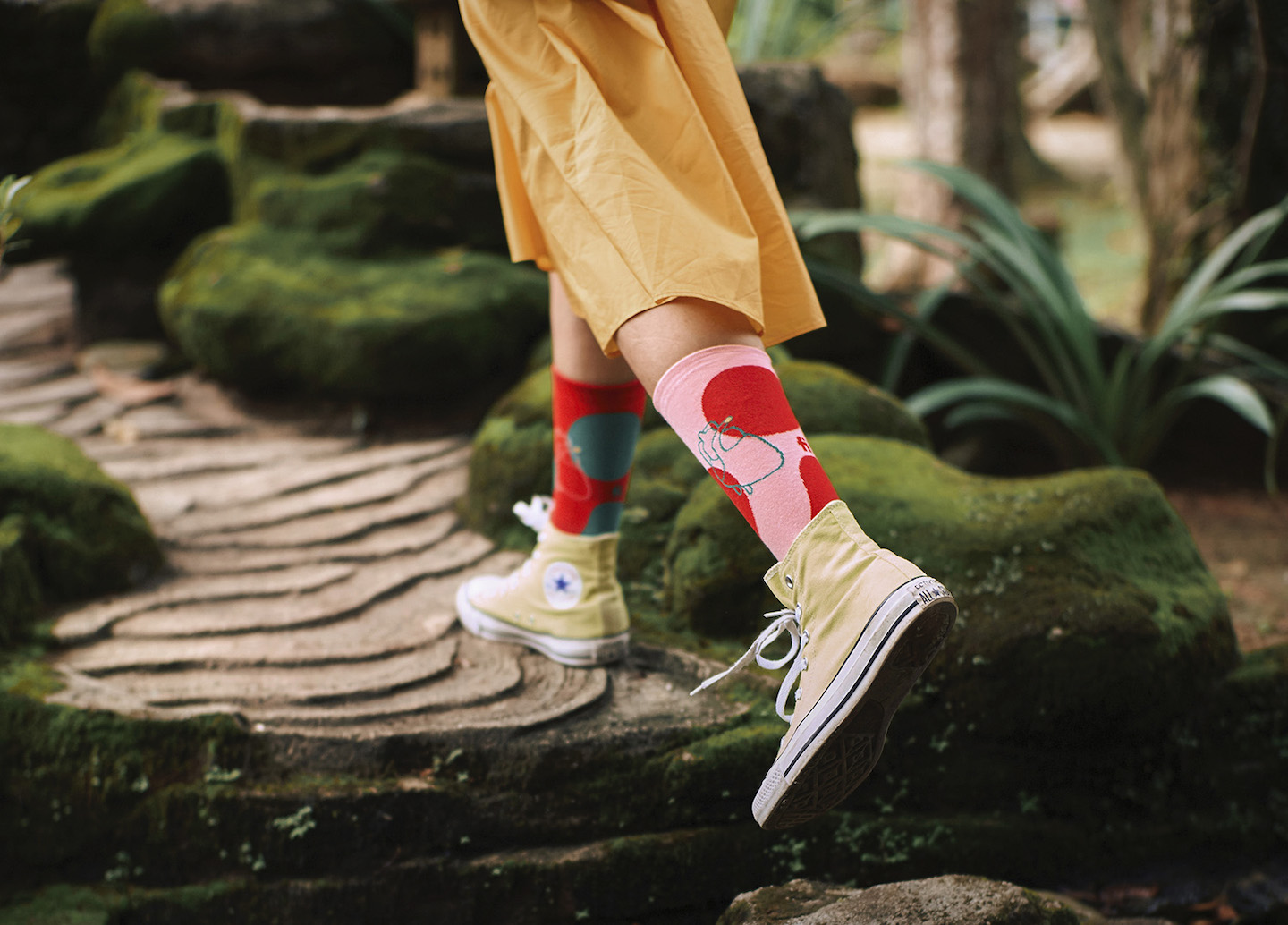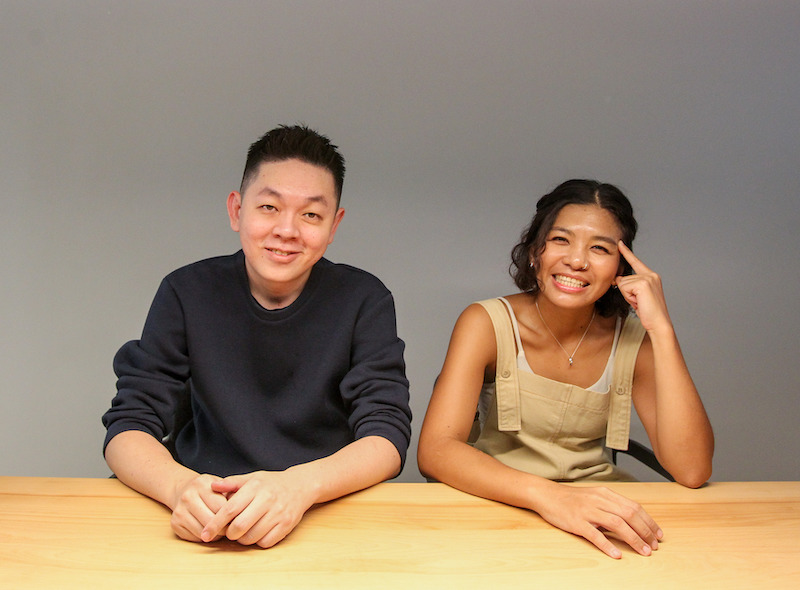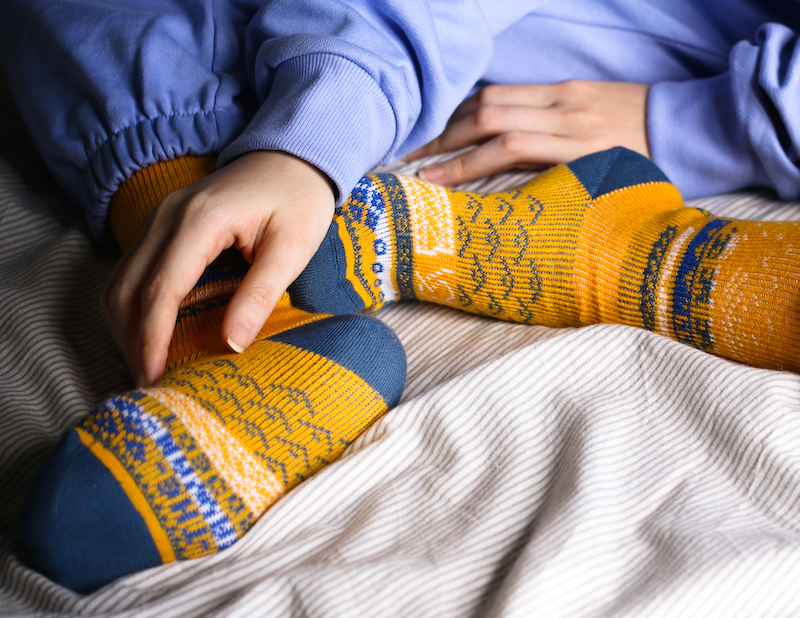
Goodpair Socks took its time to develop a locally inspired brand that focuses on high-quality and unique socks (Photo: Goodpair Socks)
Socks are an article of clothing we often take for granted, but Wong Foong Tyug and Kweok Sin Fui wanted to change that. Having dreamt of starting a business together after their wedding in 2014, they decided to take the plunge and began sourcing high-quality socks from places they travelled to, such as Taiwan and Japan, and selling them at local bazaars. Now, with their own brand Goodpair Socks, the couple have moved up the value chain, designing and producing their collections.
Wong and Kweok have a mutual love for socks. “I think socks are an essential product. It’s something that does not get much attention like T-shirts and glasses, but we think socks are something so interesting that can show your personality. When people wear a cool pair of socks, it shows there is something special about that person. I personally like to wear simple clothes with colourful socks,” explains Wong.
The couple have a background in graphic design and have been able to use their creativity to come up with fun designs. Ensuring their production stayed local was one of their key aims, though this meant that they initially struggled to find a manufacturer who would allow them to have a smaller minimum order. Although they were excited about their first collection, it did not do well. “We were quite ambitious and confident with our first collection, but the sales were not good. We only sold three pairs on the first day of the bazaar. We had 3,600 pairs in our house and after that day, we thought we would be wearing those socks for the rest of our lives,” laughs Kweok.
20211005_peo_goodsock_samkweok_sin_fui_sb-1.jpg

Wong and Kweok realised that the local market was not too keen on fun socks from an unknown brand, so they switched tactics. After posting pictures of their socks on US e-commerce platform Etsy, they found willing customers. “It turned out that our first order was from someone who worked at Etsy and she wrote a pretty good review on our product page. From there, our sales began to pick up. Slowly, in two years, we sold out our first collection. From there, we got messages from stores in the UK and Australia, and they wanted to put our socks in their stores. Bit by bit, we grew organically,” says Wong.
When they were exploring production options, they found that most local manufacturers were only used to basic socks, some with a small logo, so Goodpair Socks’ creative designs were out of their comfort zone. “It just so happened that our manufacturer was slowly passing control over to the younger generation, their daughter, who wanted to try something new. We met at the right time. She was willing to reduce the minimum order quantity (MOQ) and try our designs,” explains Wong.
Since its inception, Goodpair Socks has released more than 10 collections. One that really helped cement the brand’s identity was Dear Buncho, a collection that Wong feels really represents our local identity. “You know Buncho — the paints we used in school? That collection was about our childhood memories. We always drew certain things like buah-buahan tempatan and the undersea world. We wanted to recreate that on the socks, and dedicate this collection to our imagination and Buncho, our friend that helped us bring it to life,” she says. This collection appealed to both international and local markets as it was a unique interpretation of Malaysian-ness.
img_2999.jpg

Goodpair Socks’ designs are influenced by our local heritage, but in a deeper way that does not rely on our usual icons such as orangutans and the bunga raya. “We are inspired by our childhood, our journey as we grew up and our experience of Malaysian culture,” says Kweok.
The couple is very proud of the brand’s Good Kawan Project, through which it collaborates with local brands and designers, such as Nelissa Hilman, Salang Design and Anaabu, to come up with a unique pair of socks that highlights their individual identities. The collaboration allows the brands to grow their customer base. “Our MOQ is still quite high but with the Good Kawan Project, we are able to solve part of that problem. So, when we make 1,000 pairs, we can split the goods — they handle half and we handle half,” says Kweok.
Other than their fun designs, what makes the brand’s socks unique are the little well-thought-out features. First is the seamless toe closure, an aspect found mostly in baby socks and premium sock brands. There is also cushion padding, great moisture wicking, targeted compression, a deep heel pocket for a better fit and high-density stitching to ensure comfort and durability. “A lot of socks out there are quite pricey, especially for certain designs, but the quality is only okay. We feel there is room for improvement, so we make socks that are beautiful and of high quality. It’s why our name is very direct — we want to make a good pair of socks,” says Wong.
The majority of Goodpair Socks’ products are sold through overseas stockists or e-commerce platforms such as Etsy and Shopee. By stocking their socks on larger platforms, Wong and Kweok have been able to tap into larger audiences. Still, they felt a website would be essential to establish their brand identity, so they set one up about two years ago.
Over the years, Goodpair Socks has focused on casual and dress socks. But this year, the couple decided to explore sports socks with their Primo collection. “When creating this collection, we thought about how sports players always have their numbers on their backs, and we thought why not put these numbers on our socks?” says Kweok. For this collection, customers can pick any two numbers to feature at the back of their socks, giving them the freedom to customise their own pair.
In the future, the couple hope to make Goodpair Socks a household name by continuing to design locally inspired socks of the highest quality. Wong and Kweok share a few details about their upcoming collection that is set to be released at the end of October. “It’s a Good Kawan Project collection with [fashion designer] Cassey Gan. The collection is called Kindergarden — intentionally misspelled — and it’s about the idea of your safe zone, where you can plant a seed and grow your imagination,” says Kweok.
This article first appeared on Oct 11, 2021 in The Edge Malaysia.


